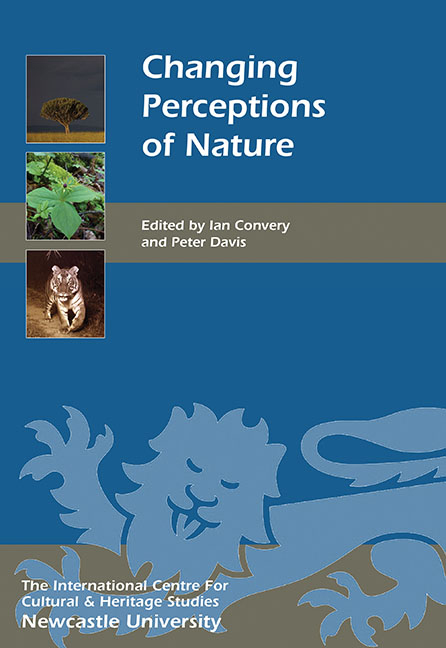Book contents
- Frontmatter
- Contents
- List of Illustrations
- Acknowledgments
- List of Abbreviations
- Foreword
- Introduction
- HISTORICAL PERSPECTIVES ON NATURE
- COLLECTING NATURE
- INTERPRETING NATURE AND LANDSCAPES
- CONSERVING NATURE
- PEOPLE–NATURE INTERACTIONS
- 22 Adventure, Nature and Commodification
- 23 Destination Nature: Wildlife and the Rise of Domestic Ecotourism in Britain, 1880–2015
- 24 Wild Places as Therapeutic Environments
- 25 Citizen Science and the Perception of Nature
- 26 Using Community-based Cultural Tourism to Enhance Nature Conservation in the Rupununi, Guyana
- 27 Representing Natural Heritage in Digital Space: from the National Museum of Natural History to Inuvialuit Living History
- 28 Out of the Wild Wood and into our Beds: the Evolutionary History of Teddy Bears and the Natural Selection of Deadly Cuteness
- 29 Rewilding: the Realisation and Reality of a New Challenge for Nature in the Twenty-first Century
- List of Contributors
- Index
- Miscellaneous Endmatter
24 - Wild Places as Therapeutic Environments
from PEOPLE–NATURE INTERACTIONS
Published online by Cambridge University Press: 26 October 2017
- Frontmatter
- Contents
- List of Illustrations
- Acknowledgments
- List of Abbreviations
- Foreword
- Introduction
- HISTORICAL PERSPECTIVES ON NATURE
- COLLECTING NATURE
- INTERPRETING NATURE AND LANDSCAPES
- CONSERVING NATURE
- PEOPLE–NATURE INTERACTIONS
- 22 Adventure, Nature and Commodification
- 23 Destination Nature: Wildlife and the Rise of Domestic Ecotourism in Britain, 1880–2015
- 24 Wild Places as Therapeutic Environments
- 25 Citizen Science and the Perception of Nature
- 26 Using Community-based Cultural Tourism to Enhance Nature Conservation in the Rupununi, Guyana
- 27 Representing Natural Heritage in Digital Space: from the National Museum of Natural History to Inuvialuit Living History
- 28 Out of the Wild Wood and into our Beds: the Evolutionary History of Teddy Bears and the Natural Selection of Deadly Cuteness
- 29 Rewilding: the Realisation and Reality of a New Challenge for Nature in the Twenty-first Century
- List of Contributors
- Index
- Miscellaneous Endmatter
Summary
I go to nature to be soothed and healed, and to have my senses put in tune once more.
John Burroughs (1837–1921)INTRODUCTION
Claims relating to the healing properties of nature have been evident in the literature for several centuries and these assertions have been supported by anecdote and observation for at least as long (Kaplan and Talbot 1983).
For one patient who will be stirred to rational reflection or conversation by such a thing as a picture, twenty of the ordinary inmates of asylums will be so stirred in connection with the prospects of the crops, the points of a horse, the illness of a cow, the lifting of the potatoes, the growth of the trees, the state of the fences, or the sale of the pigs.
(Tuke 1882, 384)A substantial body of evidence now exists to support the claims that time in nature can promote health, reduce stress (Sempik 2008), enhance mood state (Barton et al 2012), reduce cognitive fatigue (Fieldhouse 2003), lower levels of aggression (Kuo and Sullivan 2001) and promote higher levels of social and nature connectedness (Taylor et al 2014). However, despite the number of references made to the healing properties of nature over this extended period, there remains a lack of clarity as to what the therapeutic mechanisms are and the components required for efficacious interventions (Annerstedt and Wahrborg 2011). In addition, knowledge of which are the properties of nature that reap the greatest benefits, and under what conditions, remain elusive (Park et al 2011).
This chapter seeks to explore a small number of issues through critical engagement with the contemporary literature. Throughout the discussion it is acknowledged that culture and contemporary views on conservation exert a powerful influence over practice. The questions of particular relevance are: why might ‘wild’ places serve as a catalyst for healing? How robust and focused is the evidence base for such a proposition? What are the implications for practice and how can researchers provide a compelling argument for nature-based therapy moving forward? To respond to these questions, it is necessary to examine the assumptions that have been made about the terms ‘wild’ and ‘therapy’.
- Type
- Chapter
- Information
- Changing Perceptions of Nature , pp. 245 - 252Publisher: Boydell & BrewerPrint publication year: 2016

